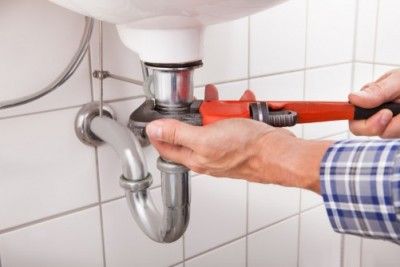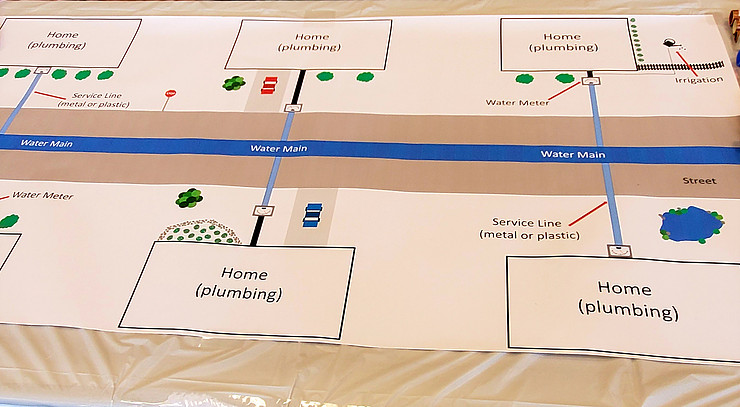How to Understand Your Property's Plumbing System Anatomy
How to Understand Your Property's Plumbing System Anatomy
Blog Article
The content directly below on the subject of Plumbing Installation 101: All You Need to Know is seriously informative. Give it a try and draw your own personal findings.

Recognizing how your home's plumbing system functions is important for each home owner. From supplying tidy water for drinking, cooking, and showering to safely eliminating wastewater, a properly maintained plumbing system is vital for your family members's health and comfort. In this thorough overview, we'll discover the intricate network that comprises your home's pipes and deal pointers on maintenance, upgrades, and dealing with common problems.
Introduction
Your home's plumbing system is greater than simply a network of pipelines; it's a complex system that ensures you have access to tidy water and reliable wastewater elimination. Knowing its parts and just how they collaborate can assist you avoid pricey fixings and make sure whatever runs efficiently.
Basic Elements of a Pipes System
Pipelines and Tubes
At the heart of your pipes system are the pipelines and tubing that bring water throughout your home. These can be constructed from different products such as copper, PVC, or PEX, each with its advantages in terms of longevity and cost-effectiveness.
Components: Sinks, Toilets, Showers, etc.
Components like sinks, bathrooms, showers, and tubs are where water is made use of in your home. Comprehending just how these components connect to the plumbing system assists in detecting issues and intending upgrades.
Valves and Shut-off Points
Valves manage the circulation of water in your pipes system. Shut-off shutoffs are critical throughout emergency situations or when you require to make repairs, permitting you to separate parts of the system without interfering with water circulation to the whole residence.
Water Supply System
Key Water Line
The major water line attaches your home to the municipal water or a private well. It's where water enters your home and is distributed to various fixtures.
Water Meter and Stress Regulatory Authority
The water meter procedures your water usage, while a pressure regulator makes certain that water moves at a secure stress throughout your home's pipes system, stopping damages to pipes and fixtures.
Cold Water vs. Warm water Lines
Comprehending the distinction between cold water lines, which provide water straight from the main, and warm water lines, which bring heated water from the hot water heater, helps in fixing and planning for upgrades.
Drainage System
Drain Pipes Piping and Traps
Drain pipes carry wastewater far from sinks, showers, and bathrooms to the sewer or septic system. Catches avoid sewage system gases from entering your home and likewise trap debris that could create blockages.
Ventilation Pipes
Ventilation pipes permit air into the drainage system, stopping suction that could reduce drain and create traps to vacant. Proper air flow is necessary for maintaining the honesty of your plumbing system.
Value of Proper Drainage
Making certain proper water drainage avoids backups and water damages. Frequently cleansing drains and keeping catches can avoid costly repair services and expand the life of your pipes system.
Water Heater
Kinds Of Water Heaters
Hot water heater can be tankless or traditional tank-style. Tankless heating units heat water on demand, while tanks store warmed water for instant usage.
Updating Your Plumbing System
Factors for Upgrading
Upgrading to water-efficient components or replacing old pipes can enhance water quality, lower water expenses, and increase the worth of your home.
Modern Plumbing Technologies and Their Advantages
Explore modern technologies like smart leak detectors, water-saving bathrooms, and energy-efficient water heaters that can conserve money and minimize ecological impact.
Price Considerations and ROI
Compute the upfront expenses versus long-term cost savings when taking into consideration plumbing upgrades. Several upgrades pay for themselves through lowered energy costs and fewer repair services.
Just How Water Heaters Attach to the Plumbing System
Recognizing how hot water heater connect to both the cold water supply and hot water circulation lines helps in identifying problems like insufficient hot water or leaks.
Upkeep Tips for Water Heaters
Regularly flushing your hot water heater to remove sediment, examining the temperature level settings, and checking for leakages can expand its lifespan and enhance power efficiency.
Typical Pipes Problems
Leakages and Their Reasons
Leakages can happen because of maturing pipelines, loosened installations, or high water pressure. Attending to leakages promptly avoids water damage and mold development.
Obstructions and Blockages
Blockages in drains pipes and bathrooms are usually brought on by purging non-flushable things or a build-up of grease and hair. Utilizing drain displays and bearing in mind what decreases your drains can avoid clogs.
Indicators of Plumbing Troubles to Expect
Low tide stress, sluggish drains, foul odors, or abnormally high water costs are indications of possible pipes troubles that need to be addressed promptly.
Plumbing Maintenance Tips
Routine Evaluations and Checks
Schedule yearly plumbing inspections to catch problems early. Search for indications of leakages, deterioration, or mineral build-up in faucets and showerheads.
DIY Upkeep Tasks
Basic tasks like cleansing tap aerators, looking for commode leakages using color tablets, or insulating revealed pipelines in cold environments can protect against significant plumbing issues.
When to Call a Specialist Plumbing Technician
Know when a plumbing concern needs specialist expertise. Trying complex repairs without proper expertise can cause more damage and higher fixing expenses.
Tips for Reducing Water Use
Basic behaviors like repairing leakages immediately, taking much shorter showers, and running complete tons of laundry and recipes can save water and reduced your utility costs.
Eco-Friendly Plumbing Options
Take into consideration sustainable plumbing materials like bamboo for flooring, which is durable and environment-friendly, or recycled glass for countertops.
Emergency situation Preparedness
Steps to Take Throughout a Pipes Emergency
Know where your shut-off valves lie and just how to shut off the water system in case of a burst pipe or significant leak.
Importance of Having Emergency Situation Get In Touches With Handy
Maintain contact info for local plumbings or emergency solutions easily offered for quick response during a pipes dilemma.
Environmental Influence and Preservation
Water-Saving Components and Appliances
Mounting low-flow faucets, showerheads, and commodes can substantially lower water usage without giving up performance.
Do It Yourself Emergency Fixes (When Applicable).
Momentary repairs like utilizing air duct tape to spot a leaking pipe or putting a container under a dripping tap can decrease damage till an expert plumber shows up.
Verdict.
Understanding the makeup of your home's pipes system empowers you to preserve it effectively, saving money and time on repair work. By adhering to regular maintenance regimens and staying educated concerning modern pipes technologies, you can ensure your plumbing system runs efficiently for years ahead.
The Anatomy of Your Home s Plumbing System
Understanding the anatomy of your home s plumbing system is essential for any homeowner. It not only helps in identifying potential issues but also facilitates effective communication with professionals when repairs or upgrades are needed. Your home s plumbing system is more than just pipes and faucets; it s a complex network that ensures the efficient and hygienic flow of water in and out of your house. In this blog, we ll dissect the crucial components of your home s plumbing system. For those in Antelope Valley, Brock Plumbing is your trusted partner for all your plumbing needs, ensuring your system functions smoothly and efficiently.
Water Supply System
Main Water Line: This is where your home s plumbing system begins. The main water line connects your home to the public water supply or a private well. Pipes and Shut-off Valves: Pipes distribute water throughout your home. Shut-off valves are crucial for controlling the flow of water and making repairs without shutting off the entire system. Drainage System
Drain Pipes: These pipes carry waste and water away from sinks, toilets, and showers. Vents: Vents allow sewer gases to escape and help maintain proper pressure in the drainage pipes, ensuring efficient flow of wastewater. Traps: Every fixture has a trap, a U-shaped pipe that holds water and prevents sewer gases from entering your home. The most common is the P-trap under sinks. Fixtures and Appliances
Fixtures and appliances are the most interacted with parts of your plumbing system. They include sinks, toilets, showers, dishwashers, and washing machines. Each fixture and appliance has its own supply and drainage connection, ensuring they receive clean water and can dispose of wastewater effectively.
Water Heating System
Your water heater is a crucial component, providing hot water to various fixtures and appliances in your home. It can be tank-based or tankless, with each type having its own set of advantages and maintenance requirements. Regular maintenance is essential to ensure efficient operation and extend the lifespan of the unit.
Sump Pump
In areas prone to flooding or with high water tables, a sump pump is an essential part of the plumbing system. It s installed in the lowest part of your basement or crawlspace and pumps out water that accumulates, preventing flooding and protecting your home from water damage.
Septic System
Homes that are not connected to a municipal sewer system have a septic system and an underground wastewater treatment structure. Understanding how to maintain your septic system is crucial to prevent backups, odors, and early system failure.
Conclusion
Your home s plumbing system is a complex and essential network, ensuring the efficient and hygienic flow of water in and out of your property. Understanding its key components helps in maintaining it properly and identifying issues before they escalate into major problems. For residents in Antelope Valley, Brock Plumbing is dedicated to providing top-notch services, ensuring that every part of your plumbing system is in perfect working order. Trust our team of professionals to handle all your plumbing needs, ensuring your home remains comfortable, safe, and well-maintained.
https://brockplumbinganddrains.com/blog/the-anatomy-of-your-homes-plumbing-system/

Hopefully you enjoyed reading our part about Plumbing Installation 101: All You Need to Know. Thank you for taking a few minutes to read our short article. Liked our blog entry? Please quickly share it. Help other people find it. We enjoy your readership.
Schedule Here Report this page